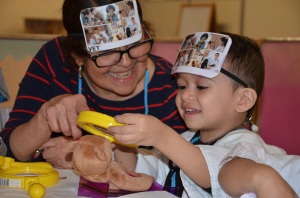Engineering and Math
HawkWatch International: Using Hands-on, Real-life Learning to Improve Student Achievement
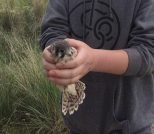
What were the goals of the project?
The goals of the “Cavity Nester Citizen Science Study” fall into four categories:
- To improve science proficiency in local high school students by giving students the opportunity to participate in real scientific research.
- To get students outdoors as part of their education.
- To support the community and create community awareness of cavity-nesting species.
- To learn more about the movements, environmental impacts, and causes behind declining populations of local cavity-nesting birds and what we can do to conserve these species.
How were these goals achieved?
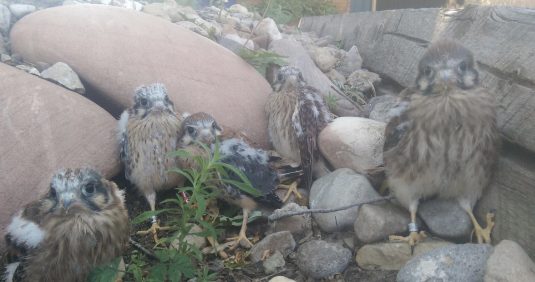
The project team hosted professional development workshops for teachers to introduce them to the project and explain how it supports the state’s curriculum. Lesson plans in biology, statistics, and environmental science were created. The lesson plans are shareable so the project can be replicated in other schools.
Students were trained how to properly monitor next boxes and cavities. HawkWatch International led trips for students to learn about and assist with banding birds. Utilizing their new skills, students monitored nest boxes and cavities near their school, conducted weekly habitat assessments, and recorded their data observations in field journals. They formulated hypotheses, analyzed the data collected, and formed conclusions about the birds being studied. Students presented their findings in a symposium open to their peers, families and the broader community.
What challenges were experienced along the way and how were they addressed?
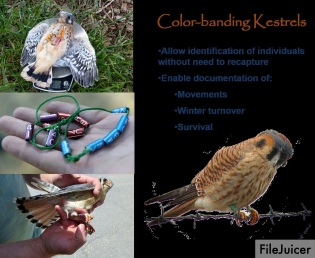
Like most organizations, HawkWatch International was deeply affected by the COVID-19 pandemic. Of the four schools originally involved, two had to drop the program and the remaining two temporarily closed. Since they were unable to physically visit classrooms or take students out to check nest boxes, they were forced to pivot to virtual visits. The project later transformed into a hybrid approach, providing a mix of virtual and real-life visits to classrooms.
Exciting plans for the future:
HawkWatch International hopes to eventually pilot this project outside of the Wasatch Front in Utah to reach more students and transform them into conscientious environmental stewards eager to take an active role protecting the habitats of cavity nesting birds.
Additional resources:
Design Thinking in Middle School: A Human-Centered Approach to 21st Century Learning Vision
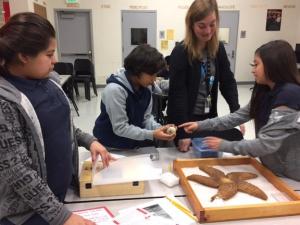
Technology advances at a rapid pace. So fast that it often outpaces advancements in education policy and practice. Students are often way ahead of the curve while teachers who learned pedagogical methods in days when there were many less avenues for incorporating technology into classrooms lag far behind them in terms of technological facility. This is compounded by the fact that every student learns in a different way, and with more and more options, it gets increasingly difficult to cater to the individual needs of students. This is what makes the Design Thinking in Middle School: A Human-Centered Approach to 21st Century Learning Vision project really stand out. They aim to bolster the technological aptitude of their educators while designing more individualized curriculum for their students. In pursuit of this vision for student learning, a team of teachers at Southeast Middle School applied with their Board of Education to open a magnet center on campus. The focus of this magnet center is to bring a three “I” – Interest, Impact, and Innovation- driven approach to teaching and learning.
Goals
In order to better understand where they find themselves as of their last progress report, it’s important to understand the goals they set out to accomplish.
Students will work on collaborative, cross-curricular projects that center on design thinking, a powerful learning tool that teaches students to use empathy and critical thinking to tackle problems of any kind from a human-centered point of view. In their model, the teacher’s role is to provide opportunities for discovery and to guide students to understanding through their innovation projects. The transition from a teacher-centered, depository learning framework to a student-centered, design-based learning approach requires teachers to work in a highly collaborative environment to develop cross-curricular and student-centered projects.
So, in their first year, how did they go about doing this?
Before they could start they had to answer a few key questions for themselves, and anyone looking to replicate this program would do well to do the same.
- What resources are currently available and/or necessary to obtain in order to successfully realize their stated vision?
- How might the concepts learned in the theme-based professional development activities be applied to their specific school context?
- What effect(s) might a design thinking approach to teaching and learning have on school performance, as measured by five instructional pillars (teaching) and the ISTE 21st century skill standards (learning)?
These questions guided their approach and the following methods were applied.
- Conduct a needs assessment and establish a teacher growth plan,
- Plan and implement teacher developed lessons tailored to the classroom context, and
- Evaluate the impact of the project on student learning and extract teacher learning through reflective practices.

Their first year found its focus in the first two milestones. One of their priorities this year was to help the new magnet teachers build a theoretical grounding in the foundations of design thinking in K-12 education. They found early on in the project that this looked different for every teacher, based on their subject area, experience level, and their personal interests in areas of growth. Because of these disparate levels of experience, as a team, they decided that more experienced teachers would take on a more robust menu of learning opportunities that were designed to fill in gaps in theoretical and clinical knowledge and to prepare themselves to be teacher leaders in the new school. Their primary learning focus as a teacher leader team was to increase their capacity to understand and teach in alignment with a program theme of design thinking through project-based learning.
So, a year in, where are they?
Their collection of professional development opportunities during Year One has helped teachers develop a greater capacity for executing the magnet program’s vision of developing a human-centered approach to 21st century learning. Teacher leaders are using their learnings from model school visits, workshop and trainings, and collaborative planning sessions, to develop a comprehensive instructional technology plan, to plan and implement theme-based lessons tailored to their classroom contexts, and to develop a comprehensive introductory professional development plan for novice teachers. This included the teacher leaders themselves sharing their learnings through professional development sessions that they curated from their experiences in Year One of the project.
Students were able to develop their skills as digital citizens, innovative designers, knowledge constructors, creative communicators, empowered learners, and global collaborators through design-based, project-based learning tasks throughout the school year. Additionally, they were able to showcase their learning at multiple community events at their school site and within the larger learning community of South Gate. News and pictures of the events were shared on the school website at <http://southeastms-lausdca.schoolloop.com/>. Teacher-leaders are currently designing their digital portfolios to showcase their student projects on the magnet program website <www.dreamsmagnet.org>.
But no project is without challenges. What were some that they faced?
The biggest thing they had to contend with was finding substitute teachers within the budget. This allowed the participating educators to take time off from class for professional development. This is being solved in the second year by reallocating some of the grant money to pay for that.
It’s never too late to educate yourself on the latest technology. Even though chances are, by the time you’ve mastered it there will be something new. But that shouldn’t stop us from trying to narrow the technology gap between students and educators, and this project sounds like one way to do it.
Further reading
Math and Maritime Place-Based Learning – M2BPL Re-thinks Math Workshop
Math and Maritime Place-Based Learning

Rig up the mast, batten down the hatch and come sail away with the educators at the Blue Heron School in Port Townsend, Washington as they embark on their exciting project: Math and Maritime Place-Based Learning – M²PBL. The district’s Maritime Discovery Schools Initiative (MDSI), implemented in 2014, is guiding their transformation by encouraging teachers to change instructional pedagogy, increase student engagement, and experience connections between classrooms and business partners. This proposal develops 30 teachers over three years.
What exactly is the Math and Maritime Place-Based Learning – M2PBL?

Research has shown these educators that students benefit highly from using a Math Workshop (MW) model.
When executed successfully, MW models support a culture of underlying beliefs:
- all students are capable of quality thinking;
- participation through hands-on activities and discourse builds student thinking;
and - through true engagement, all young minds can make real sense of mathematics.
An engaging environment is also the premise for Project Based Learning (PBL), where students use 21st century skills to learn collaboratively while working on projects to benefit themselves and others. The M²PBL proposed a structure for K-8 teachers to collaborate and design sense-making math environments tailor made for their students.
Through deepening knowledge of the Common Core State Standards in Mathematics (CCSSM) – particularly in Number and Operations, Measurement, and Geometry – teacher teams (K-2, 3-5, 6-8) focused on:
1) Number Talks (NT), a workshop element where students apply and verbally share strategies to solve and improve mental computations (number fluency),
and
2) PBL projects to apply students’ growing math strategies and conceptual knowledge. The MDSI promotes community partnerships between the school district and maritime-related industries.
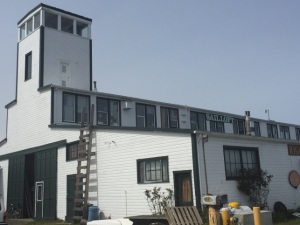
As exciting as this is for the teachers, when the students get involved it brings it to another level. The educators are partnering with Port Townsend Sails, a local business specializing in “quality sails for traditional and modern rigs.” Teachers, students, and employees will collaborate to explore authentic mathematics on-site in the sail loft. There, and in classrooms, student mathematicians will count and measure to possibly build boats, design sails, and and/or navigate!

What were the goals for M²PBL?
They had two primary goals to accomplish in year one. They wanted answers to the following questions:
- How do Number Talks increase the quality of students’ number fluency?
- Does authentic application of number fluency deepen student learning in project-based mathematics?
Eleven teachers initially met for professional learning in an elementary group and an intermediate group; each grade level met for two full days (early fall and mid-winter).
Those teachers recorded 10 half-day visits into classrooms (using a substitute) which totaled to around 15-20 visits arranged during planning times and/or with colleagues to “step out” for a short period to observe. One teacher also requested a grade level team observation one morning, so three teachers not technically a part of the grant this year joined in on observations of Number Talks. This was a productive way to share knowledge around fluency outside of the core group. Teacher texts, classroom fluency instructional materials, and PBL supplies were purchased. Items included: student journals, chart paper/markers, wood (for boats), bird feeders, bird ID texts, meter tapes, weights, calculators (specifically for order of operations), and math manipulatives for Family Math Night (dice, spinners, etc.). There, two classes taught fluency activities to parent/students, and the activities went home for continued learning. In-kind donations included dowels (masts), sail cloth (from PT Sails), sand paper/wood pieces for sanding blocks from the high school shop. Volunteer support was received from parents (chaperones), the Schooner Martha captain and family, the Northwest Maritime Center/Wooden Boat Foundation shop personnel, Carol Hasse and crew of Port Townsend Sails, the PT High School STEM/maritime students, and parents to help first graders drill boats for the mast and to tack sails to masts.
What were some of the challenges?
As we can see, they’ve been busy this year. But like all new project ideas, they are not without challenges. The biggest challenge was the collaborative work that required teachers to be out of their classrooms. One participant asked that her grade level team be able to collaborate around classroom observations, and that was accomplished. It’s also been more difficult than anticipated to get teachers to keep up with data collection. But they are already coming up with ideas on how to improve next year. Things like: 1) Supporting a full day of professional learning around math fluency/PBL for any teacher not involved in year one who volunteers (sub time/materials stipend); 2) Supporting grade level teams to collaborate around math fluency through collegial visits/observations (sub time); 3) And finally, approaching Port Townsend Rigging Company as an additional maritime partner to help expand and grow the program for years to come.
All in all, it’s an exciting project to see come together. We’re all waiting with bated breath for this ship to come back to harbor with tales of their next success.

Learn more
- Project-Based Learning: Students actively investigate solutions to complex, long-term challenges, often in groups
- Problem-Based Learning in Mathematics: ERIC Digest
- Maritime Discovery Schools Initiative
- Maritime Discovery update: Students helping salmon
The Village Science Project: Reducing Barriers to Science Education in South Sudan

While there are always needs in the schools in our own country, it is important to remember that other countries have students that have the same potential but lack even the basic resources available to many U.S. students.
This is what Candacia Greenman is aiming to address by working with the Loreto Primary School in Rumbek, South Sudan. The Village Science Project (VSP) aims to use an inquiry-driven, hands-on and play-oriented approach to improve access to high quality science education for over 200 disadvantaged students over a 3-year period in this MDEF funded academic enrichment project.
How can educators address barriers to high quality science education?
VSP intends to target the four main hindrances to science learning in their community in order to better serve the students:
- Limited resources for practical, inquiry-driven science exploration
- Poor English language acquisition
- Little community engagement
- Psychological barriers to learning
VPS’s proposed addressing these in the following ways:
- Providing students with the resources needed for science exploration through the use of science experiments and engineering and robotics projects.
- Implementing techniques to improve English language skills in science learning by promoting reading through tablets, facilitating peer learning experiences and encouraging student presentations through science fairs
- Stimulating community engagement through science fairs combined with field trips and career talks from local community members.
- Creating low-stress environments for our students, especially our girls to become interested in learning science (students are also given opportunities for “tinkering” or “free play” with science kits through the formation of an after school “tinker club”)

How can teaching methods improve students’ love for science?
Loreto Primary School serves over 600 students, with an emphasis on girls’ education and VSP will benefit about 200 different upper primary students over 3 years. The students live in a community with limited access to electricity and potable water and currently, classes are conducted outdoors under trees.
Most of these students never get a real chance to find a love of science because it’s taught almost exclusively in a theoretical, teacher-centered manner. As such, VSP is ground-breaking because of its use of a more hands-on and child-centered methodology to elevate student learning. They’ll do this by keeping a strong focus on inquiry-driven science exploration, which will help these students to develop their critical thinking skills. VSP will also deepen students understanding of, and interaction with the local physical environment as well as addressing social issues that adversely affect science education such as gender inequity, trauma-induced stress and poor community engagement.
At the end of year one the educators working on the VSP conducted initial baseline assessments of science performance and interest of Primary 5 and Primary 6 students after the following programs were implemented:
- Teacher demonstrations
- Laboratory exercises/activities
- Robotics and engineering projects
- Tablet usage
- Mathematics manipulatives usage
- Science fair
- Career talks
- Field trips
- Tinker Club
Revealing effective science and math teaching
The VSP team members have conducted baseline assessments in both science and mathematics enabling the teachers to tailor the rest of their programs according to how best to serve the students needs. In light of a mathematics assessment revealing gaps they’ve launched a mathematics intervention program targeting student understanding of number operations for Primary 3 through Primary 6 students. All teachers have adapted their teaching programs to allow for more time for Mathematics instruction and they have expanded their focus on number operations.
In addition, all of the primary school teachers attended a month-long training workshop to learn how to integrate demonstrations into their lesson plans for effective science teaching. In order to maximize the use of the science teaching aids, they expanded their focus to include demonstrations in Electricity, Magnetism and Weather modules.
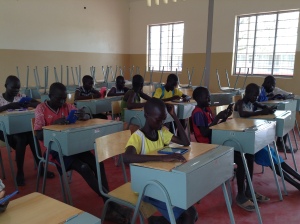
Best of all, afterschool programs to supplement students’ science education have also been implemented. In these programs, the students use science kits to expand their learning of material covered in their Electricity, Magnetism and Weather modules. Those aren’t the only exciting things going on after school for Loreto Primary School students.
VSP has also introduced programs to introduce students to engineering principles and robotics. In these programs, students have been using Engino engineering blocks to build simple machines and learn how to code using the Lightbot app as a first step towards understanding robotics. The engineering afterschool program encompasses the proposed ‘Tinker Club’ in which ‘free play’ is encouraged and students build simple machines of their choice. Students are also being provided with tablets to use in the afterschool programs to aid them in their mathematics and science courses.
One of the most exciting additions have been the science fairs which give the students a place to shine in front of Teachers, parents and other community leaders also attending the event. The science fair focused on energy and engineering and students gave presentations on the design of solar toys, the basics of electricity, and the design and utility of simple machines.

One of the greatest feathers in the cap of the VSP project is that all of their after school programs and the science fair were conducted in English and has resulted in a vast improvement in English comprehension. In addition, students have learned how to use technology and the basics of coding through the use of tablets. Their teachers have reported that tablet usage has also helped the students with Mathematics anxiety.
Lessons learned in academic enrichment
The accomplishments of this project have not come without challenges. The VSP team have reflected on ways they can improve their program in later years. Their biggest challenge was the field trips due to security concerns. As a result of this challenge, they have shifted their focus and are currently designing a “Mathematics and Science for Life” program in which students will attend weekend sessions to learn how mathematics and science are useful in everyday life. Being able to adapt and shift strategies in response to challenges is a necessity for success for a program like this.
The VSP team also learned the difficulties of relying on applications that are not as readily available on the international networks. Google Play is not enabled in South Sudan. As such, all apps must be pre-loaded before transportation to Rumbek. Unfortunately, this means that updates cannot be installed as needed. Furthermore, a lack of consistent and fast internet access has limited the utility of many apps that would be very useful for the students. And in addition to these challenges, having electricity in the classroom has been an issue. As such, they recently invested in solar energy to provide electricity to their school campus and are have installed solar electricity panels for our primary school which will improve their internet access.
All in all, it sounds like some really exciting things are going on with the VSP in Rumbek. They’re swinging with the punches and adapting when necessary. The McCarthy Dressman Education Foundation is excited to see where they go in the years ahead. If they succeed, other schools in the region will benefit enormously from the pedagogical strategies that these educators are pioneering.
Learn more about the topics in this post
- Science and Math Education for Development
- SIAM: Developing Mathematics in the Developing World
- Science Education in Developing Countries
- Revealed: World pupil rankings in science and maths
- Redefining education in the developing world
STARS: Real world inquiry excels to new heights at Research Ranch

Science, inquiry, project-based learning, and relevance take center stage in STARS.
At a time of such ecological uncertainty, when some of our greatest minds have given us 1000 years as a species until extinction, one thing is abundantly clear: the study of celestial bodies, near and far, has never been more important. And while 1000 years may be a bit far off to even comprehend, it behooves us to broaden our understanding of our neighboring planets in stars in hopes that when the time comes for us to leave our terrestrial trappings behind, we’re ready.
This is exactly what educators at George West High School have been working on for the past two years with their innovative STARS (South Texas Astronomical Research for Students) program.
“It has widely been assumed that scientific research and especially astronomical research was an endeavor to be pursued at the university level, and even then primarily by graduate students, certainly not at the high school level. STARS challenges that notion.”
-Kenneth Zeigler
Research Ranch Cultivates Learning
STARS is not limited to astronomy. At Research Ranch, tiny ranch by Texas standards of only 34 acres, introduces students to real research in the following fields of study:
- Astronomy
- Solar energy to electricity conversion
- Ecology
- Materials engineering
- New techniques in ranching (the solar ranch)
According to the report, in the first two years of this project all the areas above demonstrated tremendous progress in regards to research. Current efforts continue to focus the project primarily on astronomy, materials engineering, and solar energy.
A Converted Marching Band Trailer becomes a Mobile Astronomical Observatory
One of the most exciting developments of the past year was the STARS observatory telescope coming fully online to fully begin the program. It’s housed in the Mobile Astronomical Observatory, an 8 by 16 foot, 30-year-old converted marching band trailer.
This year saw the final steps of the transformation into a scientific research facility. Even receiving a brand new coat of paint and its official logo as the school year began.
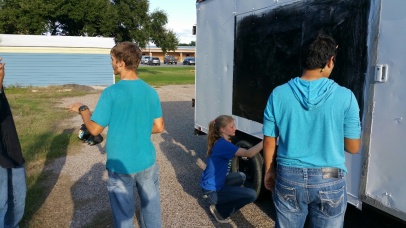
The mobile observatory is divided into a control room and telescope room section. Most of the student researcher’s time is spent in the control room which is climate controlled.
The primary instrument used this year with the telescope was the thermoelectrically cooled CCD camera that could be used to take timed exposures of the heavens as well as make measurements of star brightness at a variety of wavelengths. This opens the possibility of making measurements of color and surface temperature of stars or the shapes and rotational periods of asteroids. The student operators, CCD camera and main telescope are shown in the slideshow below.
Rocketry Club Qualifies for National Competition
The observatory isn’t the only thing to be excited about. An unexpected offshoot of the astronomy program has been a new rocketry program. Interest in the mobile observatory inevitably led to an interest in all things space, and it led students to pursue the Team America Rocketry Challenge. Two teams from George West High School participated in this nationwide competition. The challenge was to build a rocket that would carry two raw hen eggs to an altitude of exactly 850 feet and return them to the ground undamaged in a flight time between 44 and 46 seconds. This is a most difficult task and one of the two teams (Cloud 9) qualified for the national competition.

Solar Voltaic Arrays Support Real World Agricultural Inquiry
The solar ranch is another reason to celebrate this program. Junior Ryan Repka has been working on two different designs for photovoltaic arrays. The first one is the semi-active array. The first panel will be finished before the end of the school year and will be installed during the summer of 2016 with the entire photovoltaic array to be completed during the fall 2016 semester. At that point, Ryan will begin a semester long study as to the best ways to maximize efficiency, from panel positioning to water cooling of the panels.


Through repositioning of photovoltaic arrays as part of the STARS research project, an additional 15-20% solar power efficiency can be realized.While this project exceeds expectations for high school students, it continues to expand student learning opportunities.
In terms of agricultural and ecological research, the project is just beginning to make progress. In fact, an intriguing future project is taking shape. Not far from the observatory site and solar ranch, the first trees of a citrus orchard have been planted. The observatory site is a bit north of the main citrus growing region of Texas. Being on a hill out of areas of cold sinking air help, but this area is subject to serious killing frosts about one year in four. To combat this problem, the students and educators plan to develop what they are calling a microwave defroster. This system could be used to prevent frost damage on citrus but would be even more useful on more sensitive winter vegetables such as lettuce. They plan to initiate a pilot project for this device no later than the winter of 2018.
It truly is an exciting time to be a student or a teacher participating in the STARS program at George West High School. There’s something very powerful about teaching and learning while simultaneously working for a better future for all humans.
Learn More
App Development and 3D Printing for At-Risk Youth increases Learner Confidence and Problem Solving Skills through Maker Magic
“Failure is a good thing in the development world, it teaches developers quite a bit.”-App Development Instructor
Becoming good at anything is a process. Educators know that students must develop confidence in the face of mistakes and failure, because they are truly an opportunity for learning. As Bob Lenz explains in Edutopia, “failure is an opportunity for students to receive feedback on their strengths as well as their areas of improvement — all for the purpose of getting better. When reframed as a good, constructive, and essential part of learning, failure is a master teacher,” (Failure is Essential to Learning, 2015).
In this report from App Development and 3D Printing for At-Risk Youth, you’ll hear more about how a partnership at Helensview Alternative High School in Portland, Oregon, helped students build confidence and work through failure by developing 3D printed objects and apps. By integrating “maker” culture which focuses on DIY (do it yourself) engineering, students gained confidence and developed problem solving skills. Learn more below!

Why support students in making and developing?
According to the funding proposal “When Google released their diversity stats it came as no surprise that nearly every field was dominated by white men” so with an interest in building interest in STEM careers, the non-profit organization ChickTech partnered with high school teacher Brian Granse to offer making opportunities in the classroom. ChickTech, which focuses on increasing gender diversity in technology through hands-on activities, supported Helensview educators in pursuing the following project goals:
- Provide at-risk students from Helensview Alternative High School with technical workshops
- Allow students to create unique 3D printed objects and apps
- Improve students’ confidence and interest in learning
- Create lessons that can be improved upon next year and shared with others
How can you use 3D printing and app development to enhance learning and student interest?

In this project, students were offered access to workshops instead of their regularly scheduled classes. For five weeks, regular 3 hour sessions were offered on Tuesday and Thursday afternoons. Initially, others in the school were concerned about the length of the sessions, given that most students had a hard time staying involved in 45 minute classes. As the students became engaged and interested, the school community was pleasantly surprised. Students were not only engaged, but some stayed after school had ended to continue to work on their projects, a feat the report called “unheard-of” for this school.
Workshops focused on two types of making, 3D printing and app development.
3D Printing Layers Learning in Geometry and Measurement with Practical Knowledge
In the 3D printing workshops, students created multiple unique 3-D printed objects they could later take home. These included:
- personalized name plates
- custom-shaped containers
- bracelets (also personalized)
- toy cars

The workshops supported the students in learning important concepts and skills for 3D printing (explained here by 3Dify) over the course of creating the various designs, including:
- creating 3D objects using basic sketch tools such as rectangles and circles
- customizing objects with text
- adding loops to an initial sketch to build a 3D object in successive layers
- using a computer to navigate three-dimensional space
- drawing complex sketches using geometry for practical objects such as containers
- creating objects based on real-world measurements
- creating objects with functional wheels
- sketching flat designs onto curved surfaces

The more that the students learned, the more creativity they expressed. The most rewarding project for the instructors was the most complex and required the students to integrate all of the skills they were learning over time. By creating a custom built car model including customized mufflers, tailpipes, headlights, spoilers and wheels the students moved way beyond 3D modeling and into the real world – their designs even had to follow strict guidelines in order to be printable. “By the end, the students who clearly wanted to be designers stood out as did the students who wanted to be the builders of 3D printers” (Project Report) highlighting the effectiveness of the workshops focused on these skills.
App Development Builds Confidence in Problem Solving and Learning from Failure
The second series of workshops focused on app development, which also required the students to demonstrate complex problem solving skills. To get started, students followed a tutorial to learn TouchDevelop, an app creation tool, before brainstorming ideas for apps they would like to create. Once they decided what apps they wanted to develop they worked in teams to create them.
Learning how to develop apps required the students to practice and apply the following skills:
- problem solving
- content creation
- following directions
- managing time
- working in teams
Each app went through several iterations over the three week period. Two groups worked on two separate apps. One app taught about telling time on a conventional handed clock and the other taught about geometric math formulas that many students must learn for exams. Students also worked to incorporate a quiz feature that would test the app user’s knowledge of the content presented. Through trial and error, students learned about the complexity of app creation. According to the report, “Because the focus was on the process and not the finished app, students were able to explore many issues involved in developing technology for a wide audience of users. Students expressed how appreciative they were of apps that effectively solved problems as they understood how difficult it was to create and maintain a bug-free application.”
Although students came into the app creation workshops enthusiastically having already explored 3D printing, they needed a fair amount of encouragement to work through the challenges of app development. The instructor of the app development workshops wrote:
“Successful developers (app or otherwise) have a unique ability to manage frustration well, and this skill really only comes with practice and time. I did see students give up quickly at first. There was a lot of waiting for instruction rather than self guided discovery. My impression was that there was still a lot of fear attached with “failure.” Failure is a good thing in the development world, it teaches developers quite a bit. After explaining that to students, they were more inclined to try and try again without feeling frustrated. I noticed around this time, too, that students were starting to share what they were learning. If a student came up against the same bug or error message as another student had previously, it became an opportunity for those students to collaborate, and learn from one another.
We are fortunate enough to live in a world where apps are plentiful and most are very well made and fun to use. Once students learned how complex and time consuming the process really is, they were initially put off by the amount of work that loomed in front of them. Students came up with ideas that were really fun but ambitious. And once the hard work started, it was a struggle to keep the students motivated. The enormity of making an entire app that looked as flashy as something already on the market started to seem like a “why bother” scenario. But, by breaking our apps into smaller, more manageable pieces, the students had consistent success with creating new features.
There are almost infinite solutions to solving even the same problem in computer programming, so we really tried to communicate to the students that giving up is not an option. There is always something new to try. At points I know the students would have preferred to give up altogether, but I did see them gradually start to shift away from one problem to tackle another-rather than abandoning the entire project altogether. That is a very evolved problem solving technique, and one that even professional developers don’t learn until years on the job.”

Celebrating Results of a Maker Nurturing Project
After 5 weeks of workshops, the project team held a celebration party for all students, teachers, school and school representatives, and the workshop instructors. During this celebration, students showed off their projects and received feedback from the community.
Positive Response from Administration
The response was outstanding; Helensview High School administrators highlighted the value of partnerships for academic enrichment, explaining in writing:
“Schools are constantly challenged with the task of offering varied, meaningful hands-on projects, while public education is placing more focus on core academic standards and high stakes exams. Most programs lack the personnel, money, and equipment to experiment with cutting edge technologies. However, outside organizations can help tremendously with this challenge. In the case of our program, both the
McCarthy-Dressman Foundation and Janice/ChickTech have made incredible contributions that have provided at-risk youth with eye-opening, confidence-building activities that are both inspirational and academically enriching. The workshops facilitated in this program are the perfect example of how collaboration between schools and outside organizations can deliver fresh experiences that are meaningful, cutting edge, and connected to real industry people who operate beyond the walls of the public school system.By producing 3D printed objects and phone apps, our students learned that acquiring new skills isn’t just for passing tests and earning diplomas. They learned to take an idea, develop a plan, and create something real with several weeks of dense, action-packed courses in 3D printing and application development. We are grateful for the foundation’s support, and thrilled with Janice’s/ChickTech’s implementation of the programming. For everyone involved, this is time and money well spent on a once-in-a-lifetime opportunity for youth who will remember
this experience forever.”
Strong Evidence of Student Growth
According to results of pre and post surveys, students were definitely enriched by this program.
Of the group (93% non-white students – mainly African-American and Latino/a with a 63% parent education level of high school educated or below), some exciting increases were noted:
- “I plan to go to college”: 21% increase
- “I can work through problems”: 22% increase
- “I have resources I can go to when I have tech questions”: 22% increase
In addition, students self-reported an increase in technology skills. On a 1-4 reflective scale there was an increase from 1.9 to 2.9, a 52% increase. In addition, responses to the question “Would you be more interested in school if more classes were like this?” also on a 1-5 scale, averaged 4.2. The project team found this especially exciting, writing:
“Although this is a great experience for the students who attended, what if all of their classes were hands-on and interactive? What if they got to solve interesting problems, learn how to work as a team on things that affected them, and learned useful skills in every class? Can you imagine what the above numbers would look like for these students? I can, and it gives me hope for our society’s dismal track record of serving its highest-risk students.
All but one student said they would recommend that their friends take this class next year. We expect to see a strong increase in students who want to attend next year, and our instructors are so excited to improve and continue increasing their impact.”
Lessons Learned and Ideas for Improvement
ChickTech described the challenges for project implementation included finding experienced instructors, curriculum developers and drag and drop software for app development. They also noted that the educators involved were already meeting many demands in the classroom which affected the overall timeline – in fact, the student post-surveys were obtained after the project concluded which may have decreased the amount of enthusiasm shown in comments on the surveys.
In the future, the team plans to work with the same instructors so that less time can be spent on planning and their existing rapport with the students can be leveraged for more enthusiasm and interest.
Even though some of the students are moving on before next school year, some of them plan to come back as teaching assistants or to work on more advanced projects with the support of the instructors.
Funding for the project provided by the McCarthey Dressman Education Foundation supported this effort in several areas including instructor fees, teaching assistants, curriculum development, materials and evaluation costs. Sixteen students participated (50% male/50% female) which was perfect for the availability of resources within the school and the number of instructors.
Learning More about Making Projects in Education
If you would like to learn more about integrating maker culture in the classroom to build student confidence, increase gender diversity in technology, and develop complex problem solving skills, we recommend the resources below.
- MakerEd Resource Library (Maker Education Initiative, 2016)
- Jaw Dropping Classroom 3D printer Creations (Edutopia, 2015)
- MIT App Inventor (MIT, 2015)
- Mobile Makers Academy brings Mobile App Development to Schools (Tech Republic, 2014)
- App Creation Inspires Student Entrepreneurs (EdWeek, 2012)
- A Guide to Teaching Mobile App Development (Scholastic)
The Workshop Model: Focus on Communication Grows Math Expertise
In the age of the Internet, where we (kids especially) spend the much of our free time behind a screen, real interpersonal skills are at a premium. Being able to succinctly articulate your ideas is one of the greatest skills one can develop. It’s these skills that are an unintended benefit of The Workshop Model, a project funded by McCarthey Dressman Education Foundation designed primarily to help educators at Poudre High School more effectively communicate math concepts to their students. In turn, those students have practiced actively communicating with one another about how to best solve math problems. The result? Everyone learns an essential skill and everyone wins.
Maximizing learning for conceptual knowledge
The Workshop Model uses conceptual teaching (described by NCTM’s Guiding Principles for Mathematics Curriculum and Assessment, 2009) as a framework for teaching in a way that “emphasizes depth over breadth” and conceptual understanding over factual knowledge. Lessons are organized as workshops including independent and peer workshop time (see Education Week’s Minimize Lecture, Maximize Learning, 2012). According to the project proposal the Workshop Model is conceptual teaching where students engage in mathematics in three key ways:
- by solving specifically designed problems
- collaborating with their peers to discuss their problem-solving
- presenting their solutions to one another in a “math expert” type role
But before that even happens, the teachers collaborate to come up with lesson plans that foster critical thinking and reasoning from their students.
Incorporating Teacher Collaboration
With all the time constraints already placed on educators, collaborative lesson planning may seem like a tall order. While it is a lot of upfront work, the dividends (which continue to pay off) make up for the time spent. Here’s how this collaboration was organized.
- 2012-2013: Aligning Curriculum The educators at Poudre High School developed a team of Algebra I teachers to collaborate on eight units together. With each unit, the teachers created “a backwards map that included the standards, the formative assessments, right down to the specific problems students tackled to demonstrate their understanding.“
- 2013-2014: Incorporating Peer Observation For the next school year, teachers moved on to Geometry, spending eight full days to plan an additional eight units. The days were split between teacher development (lesson planning, addressing concerns, and sample tasks for students) and peer observation wherein one teacher would teach a class while the others observed and then gave constructive feedback.
The collaborative opportunities were so successful that another professional development session was scheduled in August so those teachers could improve upon their lesson plans.
Expanding Efforts
In the interests of covering all their mathematical bases, they are opting to use this years funding to put together a program for Algebra II while also continuing investing in the educators they have already worked with. This enables them to both grow the program and improve upon the pre-existing structures, but it doesn’t stop there.
In order to improve the standards of the whole district, all lesson plans were scanned and uploaded to district servers for all educators in the area to take advantage of. In addition to that, teachers from other schools are invited to take part and learn from the educators already in the program. This way those teachers can take what they’ve learned and implement it in their own schools.
How can you use this model?
The Workshop Model is very flexible and can be used to teach any subject. The major cost comes from allocating days to prepare the lesson plans for the year along with any ancillary materials dictated by the specific need of the subjects and the units contained therein. At the very least, this model should encourage more educators to collaborate and learn from one another, even if this specific model isn’t officially implemented at their school. When teachers collaborate, it is clear: no one person has all the answers, but those answers aren’t far away if you are willing to work together.
Further reading
- Concept Rich Mathematics Instruction (Ben-Hur, ASCD, 2006)
- Math Workshop: Using Developmental Grouping to Differentiate Instruction (Scholastic, 2010)
- Minimize Lecture, Maximize Learning: The Workshop Model (Education World, 2012)
- The Workshop Model for Differentiated Instruction (Aaron Allen, Teaching Channel)
Inquiry, Relevance, and Citizen Science: A Roadmap to Successful Science Projects
When students tackle science hands on, they can save the world!
If inquiry is meaningful, real world practices improve student understanding.

Memorizing the periodic table, a formula to determine the circumference of an atom, or the genus of a frog can be important, but let’s face it… you’re looking at an uphill battle when you are staring down the barrel of sixty drooping eyelids trying to explain why it is important that the student retain this information.
There is ample evidence that students retain very little from lectures in science classes. There is a reason for this – when you are given lists of equations, tables, or dozens of names to memorize it can be difficult to see where this makes an impact in the real world.
So how do we change this?
Simple. We help students impact the real world using practical inquiry into local and global science. Or better yet, take the classroom to the science! Whether students are contributing data to global honey bee research or graphing the skies, citizen science allows students to participate in global scientific inquiry. As explained here, integrating inquiry based science meaningfully in the real world is a tall order for any educator. In this post, we will share with you an example project and supporting resources to inspire this integration in your classroom.
How do educators integrate scientific inquiry and real world relevance?
The Water Quality Project: A Map to Understanding was reported by Linda Weber of Natick High School in Natick, Massachusetts. The goal of this project at is to let students “do” science like real scientists by observing, questioning, and ultimately coming up with a solution to a problem that can be shared with the larger community. In the short term, participation allows students to see and experience the process of scientific inquiry first hand, rather than having someone dictate it to them. In the long term, students who participated would see how the decisions they were making now would impact their lives in the future. According to the National Science Teachers Association’s position statement:
“Scientific inquiry reflects how scientists come to understand the natural world, and it is at the heart of how students learn. From a very early age, children interact with their environment, ask questions, and seek ways to answer those questions. Understanding science content is significantly enhanced when ideas are anchored to inquiry experiences. “
What strategies can be used to increase the real world relevance of the inquiry process?

One of the long term goals of this project included helping students see how the decisions they make today influences their future. This ambitious goal required teachers to frontload curriculum earlier in the year and to engage students with relevant narratives (like PBS’ Poisoned Waters) and a guest speaker assembly including local and regional water quality scientists.
All of this preparation helped students prepare for real world and hands on activities for the project. These included:
- Helping out their community
For the annual Charles River Watershed Association’s clean-up day, students and teachers removed a variety of trash, from traditional cigarette butts and paper to more unusual things like television sets. For the nearly 50 students that participated (on a school vacation weekend, mind you) the experience was insightful. Class discussions about and concern for their environment lingered into the following weeks in class. These shared experiences became the “reason” to investigate water quality in the community rather than the “just the wrap up activity” of the project.
-
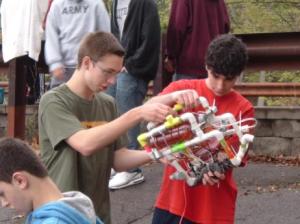
Environmental Science and Robotics classes at collection sites test and launch robots, then collect water samples to be analyzed at the site and in class. Photo from Linda Weber, Project Awardee. Collecting local data
After the students had returned to the area to collect water samples. They used collection robots they built during their classroom time to reach water samples they couldn’t normally get to. Using technologies like wikis, blogs, and Google Maps they were able to share their results instantly with their classmates. - Contributing to global datasets
The project also included research for the testing parameters of The World Monitoring Day Organization or World Water Monitoring Day. The Water Quality Project isn’t the only program in the United States doing this. Many other schools (in over 24 countries) are participating in The World Water Monitoring Challenge. It charges its members to educate and engage students and citizens in the protection of international water resources.
- Presenting the results
When all the research was said and done there was a “massive poster presentation” where every student was required to present his or her findings and share ideas for how to improve the water conditions in their community.
Why does it work?
When learning is meaningful, the impact is tangible.
When students have the opportunity to showcase their skills to a larger audience than their teachers or peers it helps to internalize the lessons they learn in the classroom. This benefit accumulates when the students can see themselves using inquiry-based science to make a real difference in their communities.
Learn more about integrating Citizen Science in education
- British Science Association: The 3Rs of Citizen Science in Education
- Zooniverse
- Audrey Watters: Five Apps that Encourage Citizen Science



